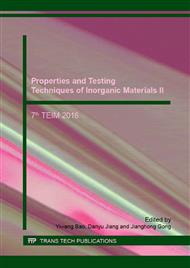p.470
p.481
p.490
p.495
p.500
p.505
p.510
p.515
p.521
The Restoration of Compressive Strength of Self-Healing Mortar
Abstract:
Self-healing mortar with various healing agent was prepared by sealing the healing agent in glass capsules. Waterglass, metakaolin slurry, and metakaolin slurry and waterglass were used as healing agent. The restoration of compressive strength of self-healing mortar was characterized by damaging the mortar at 7 and 28 days and curing for another 1, 7 and 28 days. The compressive strength of mortar with healing agent of waterglass was restored after curing for another 7 days under the condition of damaging at 7 or 28 days, and developed with a similar trend to that of the control specimen when damaged at 7 days but was not fully restored in the long term when damaged at 28 days. The compressive strength of mortar with healing agent of metakaolin or metakaolin and waterglass was restored after curing for another 7 days when damaged at 7 or 28 days, and developed with a similar trend to that of the control specimen in the long term under the condition of damaging at 7 or 28 days. Metakaolin slurry can restore the compressive strength of mortar at both early and later age damage. The combination of metakaolin and waterglass restored and further improved the compressive strength of self-healing mortar.
Info:
Periodical:
Pages:
500-504
Citation:
Online since:
January 2017
Authors:
Keywords:
Price:
Сopyright:
© 2017 Trans Tech Publications Ltd. All Rights Reserved
Share:
Citation:


